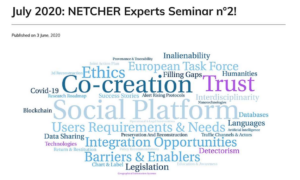The International Association of Dealers in Ancient Art has prepared a report on the results of the NETCHER Social Platform for Cultural Heritage final forum online on March 1 and 2. NETCHER is a €1.5m transnational policy research project aimed “at reinforcing the fight against cultural heritage looting and trafficking.” The project concluded by presenting 194 recommendations for action. While some of the ideas presented by the project are constructive, the conduct of the project, its extremely wide-ranging ambitions and its failure to adopt a truly evidence-based approach raise serious questions about this concept of policy formation.
IADAA’s penetrating analysis follows. CPN thanks the International Association of Dealers in Ancient Art, which enabled its publication here on Cultural Property News.
Netcher’s good ideas are lost amid its flight from reality and the grab for power and money.
In its own words, the Netcher Forum “is a transnational project, started in January 2019 with a duration of 27 months, aiming at reinforcing the fight against cultural heritage looting and trafficking, by bringing together relevant international actors (security and research communities, public and private institutions, art market specialists, policy makers) and intends to build a sustainable social online platform”.
Funded by the European Union with €1.5 million, its network of academics, archaeologists and technocrats, who had gathered in a series of workshops in various places, met in final forum in a two-day online conference on March 1 and 2, where guest organisations included UNESCO, the European Commission, law enforcement from the Netherlands and Italy, the Egyptian Ministry of Antiquities, the Antiquities Coalition, ICOM and others. By the looks of it, a large part of the budget was spent on creating an elaborate website and the organising of events.

Author: PantheraLeo1359531, A futuristic fractal. 24 May 2019. Creative Commons Attribution-Share Alike 4.0 International license.
Yet again, despite discussing the international art market at length, the one set of representatives not included were those from the international art market itself. The only attempt to invite a single representative from CINOA, the principal international confederation of art & antique dealer associations, failed because the invitations were to the final forums and the unacceptable terms on which the invitations were issued, with Netcher refusing to share any information on who was participating or the content of the forum.
As can be seen from the Netcher policy brief set out following the Lyon forum in February 2020, despite admitting that they did not have the data or intelligence to show this, they assumed “that trafficking generates an enormous amount of money, and looted objects circulate all over the world”. How does this fit in with the demand for provenance and traceability, which Netcher is so keen on? Or with Netcher’s focus on methodology at its May 28 and 29, 2019 workshop, which set out the following objectives:
- to gather a strong methodological background and deliver the most accurate and updated picture about the concepts for each thematic group; and
- to collect bibliographical data and references.
It seems that providing proof to justify one’s activities is a rule that Netcher’s delegates think should apply only to the art market. In conclusion, Netcher set out 194 recommendations for action, a list that looks like an unedited result of a brainstorm session, ranging from a recommendation to focus on source countries (as IADAA has been advising for years) and to involve more actively purchasers and the private sector (if not in the debate at Netcher itself!) to rewriting EU regulation so that most countries accept it (an intriguing prospect) and the final recommendation, which is worth reporting in full: “To connect all the actors working on the field, addressing problems of poverty, of sustainable rural development, of sustainable cultural and touristic development. This is true also at the other end of the process, when looted objects are sold: there will be no sustainable solution without the active involvement of magistrates and the art market.”
This last recommendation is exactly what IADAA, CINOA and the market in general have been calling for over the past few years, yet it has largely been ignored. As this shows, despite our strong criticisms of the way Netcher has been set up and run, some of the recommendations are certainly worth considering. But it also begs the question: how does the Netcher project expect the market to have confidence in it when it has singly failed to involve the market in the debate so far?
Despite this being an EU funded project, this comprehensive approach to recommendations was clearly not bedded in reality, as some of even its most sympathetic guest speakers pointed out, notably those with senior roles within the EU itself.
Guillaume Decot, of the EU’s European External Action Service, said that although the recommendations might be good, there were far too many of them, no priorities were given and it was not clear how they could be translated into action.
The European Parliament’s priorities were improving traceability, improving compliance mechanisms and building capacity, he said, adding that he didn’t feel the arguments were there yet to advocate setting up a new agency to deal with them. “You need very, very strong arguments (for such capacity building) and we already have agencies working on this,” he concluded.
As UNESCO – which congratulates itself on its ‘consultations’ with the art market – also fails to grasp, involving the market means giving it a say, not occasionally allowing it to attend events under sufferance, and never on equal terms with other delegates, only to dictate to it what it must do.
Despite Netcher also warning against the duplication of databases, initiatives and other efforts in its objectives (to clearly define the current situation; set up an international network; train stakeholders; manage the collaborative platform; define and international framework; and raise awareness), its entire approach echoes just about every other initiative already attempted.
Speakers talked about capacity building, additional resources and funding, while calling for more regulation and other restrictions, demands that appeared to ignore entirely what has been going on, especially within the EU, over the past five years. In brief, this came across as another attempt at empire building accompanied by calls for additional fund grabbing.
Despite Netcher’s general message that looting and trafficking were causing an international crisis, and that this involved both the art market and terrorism financing, Cecile Soriano, a Policy and Legal Officer for the European Commission focusing on Financial Crime, noted that:
- measuring the value of illicit commerce was very difficult (and they had not successfully done so).
- very limited evidence existed of the financing of terrorism activities or trafficking routes; and
- levels of reporting from auction houses and art businesses is very low and it was not clear why.
Amid the clamour for clamping down on this last perceived shortcoming, the conference failed to acknowledge the new anti-money laundering legislation, already in force in the UK and the EU and advancing swiftly in the US, which obliges the art market to report any suspicious activities.

Author: Dummyfish. A 3D fractal rendering made with Mandelbulber 2. 27 May 2019. Creative Commons Zero, Public Domain Dedication.
Occasionally the forum steered inexcusably off course into ideology and dogma: “Work with the public (including children) is crucial, because all these people are potential collectors, of course. And we have to eradicate this feeling that owning a cultural object is cool. Well it’s not. It’s not a hobby.”
So said Anna Kedziorek Ramirez, another European Commission policy officer, with responsibilities for cultural policy in the education sector, who declared herself “emotionally attached” to Netcher.
Quite apart from it being inappropriate for an EU official to promote their personal prejudices as policy in a publicly funded forum, Ramirez was advocating action against legal activity, while also appearing to condone more questionable behaviour in saying: “In order to raise awareness we need to have professional journalists who investigate the topic, and not necessarily in a sensational manner, although this seems to work wonders in some cases.”
Despite the scandal of UNESCO’s recent fraudulent advertising campaign, one of its architects, Director of Culture and Emergencies Lazare Eloundo Assomo, was on hand to promote it once more, neglecting any mention of exactly why it “annoyed” some people.
“We need to continue this kind of campaign and also to make a distinction between the licit trade and illicit trafficking,” he added, a distinction his bogus campaign dedicated enormous efforts attempting to destroy.
So it seems that UNESCO is officially advocating the continued use of public funds to mislead the public. Where is the investigation into this scandal?
Yet again, Assomo repeated the discredited claim that “illicit trafficking (of cultural property) is the third very (sic) important trafficking in the world”, qualifying this with the further untruth: “… most of the experts in the world in the last ten years have agreed about it.”

Netcher Themed Graphic, July 2020: NETCHER Experts Seminar n0 2!
How does this approach fit in with Netcher’s themed graphic (shown here) promoting “Trust”, “Ethics” and Provenance & Traceability”? (Note the absence of “Trade” or “Art Market”.)
Léonie Bouwknegt, an Operation Specialist from the Netherlands National Police, explained how she had been involved in raids at TEFAF Maastricht in early 2020, seizing items amid great media fanfare – a damaging exercise for dealer reputations (only to return them quietly later when no evidence could be found to show that they were illicit). She did not go much into detail, “because it is an ongoing investigation”. If, as she admitted, the authorities have so much trouble proving that objects are illicit, what are they doing seizing them at all, let alone so publicly? Why do they not wait until they have gathered the necessary evidence that gives them a chance of a successful prosecution? In her opinion the Dutch laws were inadequate to prosecute dealing in “tainted” objects, a remarkable complaint from a police officer. The return of these objects to dealers broke her heart, she declared – another instance of personal prejudice getting in the way of professionalism and public duty.
Luigi Mancuso, a specialist in cultural property crime for Europol, reviewed the transnational anti-crime operations of the past few years, including Pandora, Athena and Demeter. He talked of the “many objects that were red flags and that were maybe illicit”, and listed seizures and arrests made across several years. However, he did not say how many of these had led to successful convictions or confirmation that the items seized were indeed illicit. IAADA has sought these figures for some time but can find no instance of them being published.
Despite the lack of data to support this, Mancuso declared: “We have to recognise that cultural goods crime generates a huge amount of profits.” He did not make it clear whether he was talking about antiquities or cultural goods in general; and he also repeated the link to money laundering and terrorism financing, again despite the lack of evidence to show this, as acknowledged by Cecile Soriano, the Policy and Legal Officer for the European Commission focusing on Financial Crime (see above).
One of the most enlightening contributions came from senior European Commission official Elena Maidou (Administrator Cultural Goods, Customs Enforcement of Intellectual Property Rights, Controls of Cash Entering or Leaving the EU and Export and Import of Cultural Goods, DG for taxation and Customs Union (DG TAXUD)), dealing with the new Import of Cultural Goods regulation for the European Commission, who negotiated with the art market over the import licensing regulations.
“I think that from the point of view of legislation, the European Union has done quite a lot and is still in the process,” she said, in response to Netcher’s call for more regulation at the EU level.
She also explained that the Middle East crisis had made it easier to push the import licensing through the European Parliament, but added: “Since the situation has more or less normalised, if you want to propose more legislative measures… that would be more difficult. We faced a lot of opposition, not only from art market lobby groups, but also from certain member states.”
Maidou also revealed that once the EU’s electronic customs system is fully operational in checking cultural property imports, the intention is to extend it to overseeing exports.
Ultimately, the scale of Netcher’s ambition could prove to be its downfall. The EU 2021-27 budget is already set and the global pandemic has added to the fiscal crisis. Funding a vast new network of agencies, research programmes, collective operations and other projects in pursuit of 194 recommendations would be a huge challenge at the best of times. In this climate it seems completely out of touch with reality.
How the EU can fund a project like this to the tune of €1.5m without apparently briefing it on protocols, such as how to present results and recommendations, is not clear.
Some (though by no means all) good ideas have come out of Netcher, but they risk being lost in a mire of self-interest as advocacy groups involved compete for influence and funding.
Surely it is time to rethink this costly, overly bureaucratic and sclerotic approach to forming policy. It’s time to abandon these self-indulgent, all-expenses-paid international echo chambers and their obsession with capacity building and endless extra resources and funding, and replace them with a leaner, fast-moving and truly independent research model that focuses on hard data and properly evidence-based conclusions that lead to effective decision-making.
 Fractal wallpaper, Riemann - Sphere Msltoe V1 x Mengerschwamm OpenCL 938825676 32K, PantheraLeo1359531, Creative Commons Attribution-Share Alike 4.0, Wikimedia Commons
Fractal wallpaper, Riemann - Sphere Msltoe V1 x Mengerschwamm OpenCL 938825676 32K, PantheraLeo1359531, Creative Commons Attribution-Share Alike 4.0, Wikimedia Commons 

